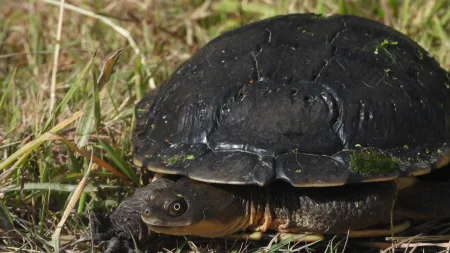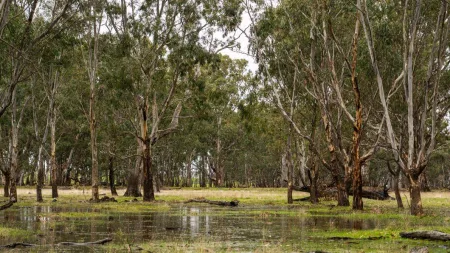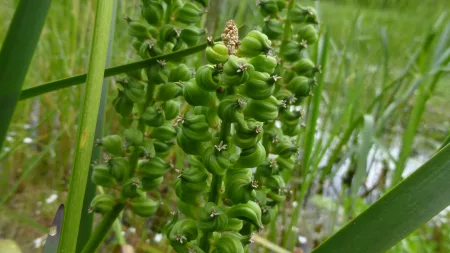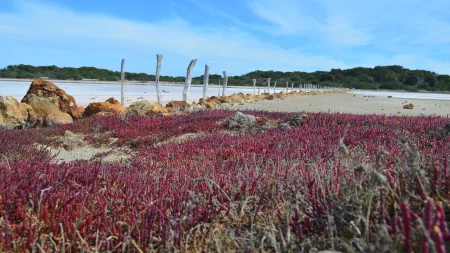Discover the plants and animals that live in Limestone Coast wetlands
Wetlands are vital ecosystems that support a wide range of plant and animal life. Wetlands contribute to the health of all communities, ours and the communities of plants and animals. Animals and plants depend on wetlands for their survival. They provide food and shelter for creatures great and small.
The Limestone Coast Landscape Board works with the community to protect, enhance and restore these precious ecosystems.
Next time you’re exploring our local wetlands be on the lookout for these iconic animals

Red necked stint
This fascinating migratory shorebird travels over 10,000 km each summer to visit our wetlands. Fuelling their body with the tiny insects and worms that live in the shorelines and mudflats alongside many of our wetlands. You might spot a red necked stint (Calidris ruficollis) at the famous Coorong, the largest estuary in the Limestone Coast.

Yarra pygmy perch
Also known as Nannoperca obscura is a small freshwater fish native to the Limestone Coast of Australia. The endangered species is found in slow moving or still freshwater habitats. Being sedentary, with low mobility, this fish is vulnerable to predation. You might be lucky enough to spot one of these at Piccaninnie Ponds.

Swamp wallaby
Hiding amongst the dense vegetation surrounding a wetland you may spot a solitary swamp wallaby (Wallabia bicolor). Native to eastern Australia these compact wallabies are covered in dark brown to black fur with a long tail that grows to around 75 cm. Enjoying the surrounds of wetlands with long grasses, trees and shrubs these marsupials feed off the variety of plant species.

Eastern long-necked turtle
Living on both land and in water the eastern long-necked turtle (Chelodina longicollis) prefers the calmer waters some of our local wetlands provide. With its slender long neck resembling that of a snake, the neck of this turtle can be as long as it’s upper shell…amazing! Feeding on a variety of aquatic creatures, these unique turtles play a vital role in the freshwater ecosystem. You may find the eastern long-necked turtle basking in the sun or hiding in the vegetation at the water’s edge at Naracoorte Creek or even the shallow wetlands that form in paddocks throughout our region in winter and spring. If you happen to lay eyes on a turtle when you are next exploring you can map it at TurtleSAT.

Southern bell frog
The endangered southern bell frog (Litoria raniformis) is one animal to listen out for! It lives in a variety of freshwater wetlands such as swamps, marshes, ponds and lakes. The Southern Bell Frog can be heard with a distinct deep “bonk” or “plonk” type call. Often heard around the Honan Forestry Reserve in the Limestone Coast as well as Bool Lagoon keep your listening ears on next time you visit a local wetland. If you happen to spot a frog or would like to identify one on your next outing you can record your observation or find out more at Frogwatch SA.
Plants also thrive in our local wetland environment
Maybe you have seen some of these plants when you have been out exploring our landscape. Some plants are fully submerged, entirely underwater and others float on the water’s surface.

River red gums
Also known as Eucalyptus camaldulensis are iconic to the Limestone Coast region. Located near wetlands, rivers and creeks these trees are tough! Able to handle floods and droughts, dropping leaves and branches when they need to. You will spot them in seasonal wetlands like Mundulla swamp and along waterways like Mosquito Creek. They are important for animals, the land and First Nations culture. They need access to groundwater to remain healthy and away from wetlands they are amazing paddock trees, providing shade and shelter for animals.

Water ribbons
Also known as Triglochin species are fascinating aquatic plants that contribute to the health and biodiversity of our freshwater ecosystems. With long dark green leaves that float on the water’s surface, they can grow up to 2 m. These plants are generally found in calm slow moving water such as marshes and shallow ponds. They provide habitat and refuge for the many fish and amphibians that live in our region’s wetlands.

Beaded glasswort
Also known as Salicornia quinqueflora is a succulent that is commonly found in saline wetlands. Salty mudflats, marshes and coastal dunes provide the perfect ground for this gorgeous plant species. Varying in colour from bright green to a distinctive deep red, beaded glasswort can be found in abundance at the Coorong, which is located in the Upper Limestone Coast. A major food source for the critically endangered Orange-bellied parrot, this plant is an important component to the salt marsh ecosystem.
Support in identifying unknown plants
If you’re unsure about a plant when you are next exploring wetlands in our region. iNaturalist is an innovative way to identify native plants. Using the app from your mobile device you can take a photo of a plant and it will be identified by a team of scientists. This is a great tool for those interested in learning more about our native plant species.
